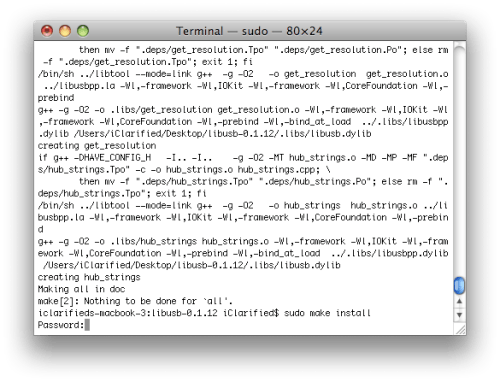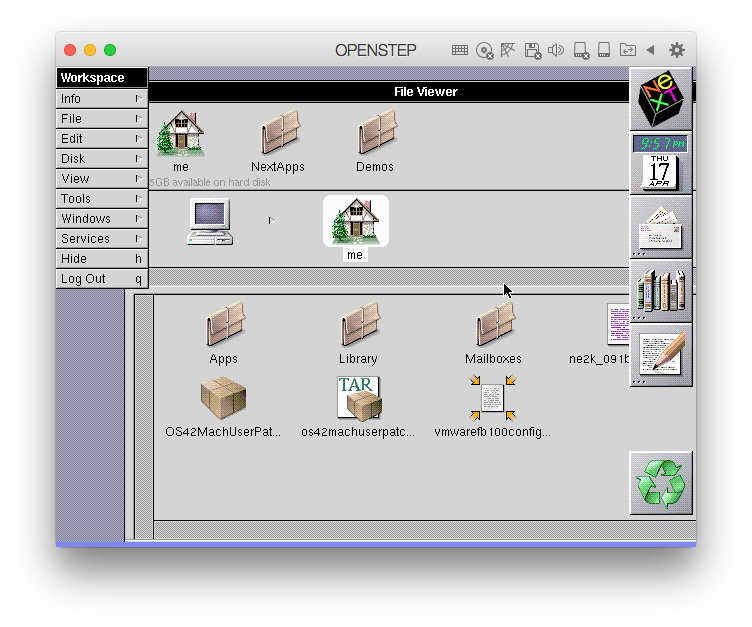Openstep Installation Instructions
NeXTStep 3.xNeXTSTEP, from NeXT Computers headed by Steve Jobs, is a Unix based operating system designed to run on m68K NeXT workstations. It later became the basis for, with APIs and concepts preserved today.This OS offered many unique things, in addition to the unique hardware it originally ran on. It had Interface Builder, a tool to create UIs with little to no code. To make building the UIs and code easier, it had robust database support to bind data with. Objective-C was the preferred programming language, a hybrid of C and Smalltalk. Underneath was a Mach microkernel and a 4.2BSD subsystem.
InformationProduct type Vendor NeXT Release date 1992 Minimum CPU 68030, 486, Sparc, HPPA User interface GUI Platform Downloads Download NameVersionLanguageCPUFile typeFile size3.1Englishx86-32,m68kCD230MB3.3Englishx86-32,m68kCD154.51MB3.2Englishx86-32,m68kCD171.02MB3.3.4.17 for Sparc and PARISCEnglishSPARC,OtherCD155.64MBNebula 1.0 IntelEnglishx86-32CD144.32MB3.0Englishm68kArchive25.5MB3.1Englishm68kArchive38.45MB3.2Englishm68kArchive39.16MB3.3Englishm68kArchive60.51MBComments.
Porting from Cocoa or OPENSTEP (NS.) to GNUstepPorting from Cocoa or OPENSTEP to GNUstep has different aspects. First there is the compatibility of the basic Foundation Kit and Application Kit. We support a lot of classes, but not all of them and the same is true for specific methods, specifically newly introduced classes and methods in Cocoa may still be missing as GNUstep started out aiming at OpenStep compatibility.Second you have all the additional frameworks and libraries programmers on Mac OS X take for granted, for some of them free replacements exists, for most they are still missing. Mac OS X developers should try and avoid CoreFoundation as this will complicate your dependency situation on non-Mac hosts, even if that part of CoreFoundation has actually been ported. GNUstep Base and the FoundationKit offer many parts of the CoreFoundation functionality in a natural manner. Porting from GNUstep to CocoaThis should be an easy transition since GNUstep implements most of Cocoa, except for the very Apple specific classes such as the scripting extensions. Since Gorm does not yet save.nib files, you will need to create the interfaces using IB.
Porting.nib files from OPENSTEP or Mac OS X 10.1 and earlierGNUstep can handle nibs from 10.2 or later of Mac OS X, but it can't read nibs made with NeXTSTEP, OpenStep or Mac OS 10.1 or earlier. On the latest version of Mac OS X, this is a simple matter of loading the.nibs into Interface Builder.app and saving them in the 10.2 format. Another possibility is using nib2gmodel, the only one when porting from OPENSTEP, and, mind you, you need to do the converting there. First, get, follow the included instructions to build and install it. Once that's done you're ready to begin:Run the nib2gmodel program on your nib:nib2gmodel mygui.nib mygui.gmodelThis should create the.gmodel as a plist. I recommend that you convert the gmodel to a 'normal' plist instead of an XML plist. You can do that by doing this on OS X:pl mygui.gmodel -input mygui.serrm mygui.serNow you can either use the gmodel as it is, or you can convert it to a.gorm file.
Gmodel to.gorm conversionNOTE: Conversion from gmodel to.gorm is experimental and will probably remain so for a while. It currently works in the majority of cases, but there are still improvements which need to be made.Conversion to a.gorm file is relatively straightforward:.


Start Gorm.app. Choose Gorm-Document-Open and find the gmodel you wish to load. Gorm will prompt you to either define the superclass for classes it doesn't know about or to parse the headers.After you've defined all of the unknown classes, Gorm should complete the conversion. Once this is done you should save the result to make sure you don't loose your work.nib to.gorm conversionSince it's possible to load nibs into GNUstep application now, it should be easy to convert 10.2 or later nibs by simply loading them into Gorm and saving them as.gorm files. This is not strictly necessary since GNUstep can handle them natively.NOTE: Our recommendation for this is not to use the nib2gmodel conversion and simply to use the nibs directly, if you can or to convert them as described above by loading them into Interface Builder and saving them as the newer nib format. Do not rely on tools available in development environmentAll the world is not Linux or FreeBSD or Windows. System constants may be different on different platforms.
Openstep Virtualbox
Paths to command-line tools, the parameters they accept and locations of temporary directories may be different to what you are used to on your platform. and the offer some of this functionality 'for free'. Try not to hard code paths and so on into your code, use macros (not recommended), or even better an abstraction mechanism. Avoid hard-coding system constants, or platform-specific ones where POSIX or commonly-accepted ones exist (and we're not talking about glibc here:-). Try to avoid advanced features of the linker, such as weak symbols, which may not be present on non-ELF systems. While this will work perfectly on most systems, it is not portable to all systems, most notably Windows. When platform-specific code cannot be avoidedThere are cases where you may need to write platform-specific code, especially in the case of desktop applications and services which make use of facilities not standardised by POSIX or by the FoundationKit and AppKit specifications, at least use.These platform-specific, or even desktop-specific requirements could be re-used by other projects - and even enhance desktop-integration efforts for GNUstep applications - by abstracting out common code into currently hypothetical and frameworks.
